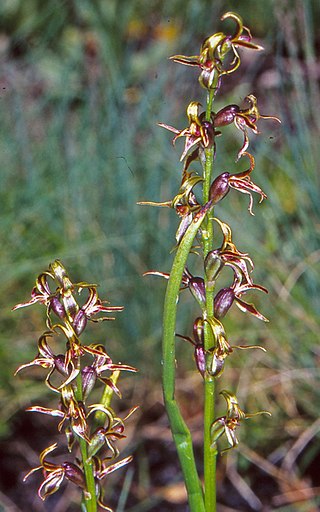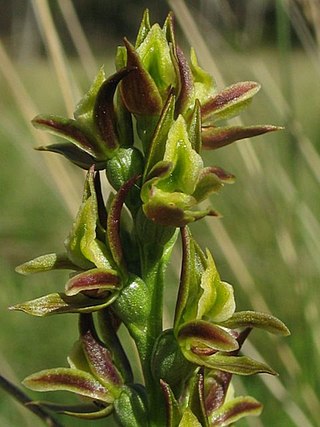
Prasophyllum sphacelatum, commonly known as the subalpine leek orchid, is a species of orchid endemic to south-eastern Australia. It has a single tubular, dull green leaf and up to eighteen scented, green to brownish flowers with a green to pinkish labellum. It grows in subalpine areas of New South Wales, Victoria and Tasmania.
Prasophyllum campestre, commonly known as the sandplain leek orchid, is a species of orchid endemic to eastern Australia. It has a single tubular, yellowish-green leaf and up to twenty greenish, strongly scented flowers with red, purplish, brown or white marks. It grows in the drier parts of Queensland, New South Wales and Victoria.

Prasophyllum wilkinsoniorum is a species of orchid endemic to New South Wales. It has a single tubular, bright green leaf and up to forty five scented, dark greenish-brown to brownish-red flowers with a green to pinkish labellum. It grows in grassy places in a restricted area on the Southern Tablelands.

Prasophyllum canaliculatum, commonly known as the channelled leek orchid or summer leek orchid, is a species of orchid endemic to a small area of southern New South Wales. It has a single tubular, bright green leaf and up to twenty five scented, greenish-red or brownish flowers on a flowering stem. It grows in woodland at altitudes around 1,000 m (3,000 ft) where only about two hundred plants survive.

Prasophyllum dossenum is a species of orchid endemic to a small area of northern New South Wales. It has a single tubular, dark green leaf and up to thirty scented pinkish-white and greenish-brown flowers crowded along an erect flowering stem. It is a rare orchid which grows in grassy places on the Northern Tablelands of New South Wales.

Prasophyllum fuscum, commonly known as the slaty leek orchid or tawny leek orchid, is a species of orchid endemic to a small region of New South Wales. It has a single tubular green leaf and up to thirty greenish brown to reddish brown flowers. There is debate about the taxonomy of the species with some authorities considering Prasophyllum uroglossum as a separate species. Only about twenty five plants are known to survive in south-western Sydney.
Prasophyllum incompositum is a species of orchid endemic to Queensland. It has a single tubular, dark green leaf and up to thirty scented, greenish-brown and white flowers. It has only been recorded from the Carnarvon National Park.
Prasophyllum keltonii, commonly known as Kelton's leek orchid, is a species of orchid endemic to a small region of New South Wales. It has a single tubular, bright green leaf and up to twenty two scented, green, brownish-red or purplish flowers. It is a very rare orchid with only a few hundred plants known.

Prasophyllum maccannii, commonly known as the inland leek orchid, is a species of orchid endemic to Victoria. It has a single tubular green leaf and up to forty green, greenish-pink or brownish flowers. It is found in the central-west of the state, growing in open forest.

Prasophyllum viretrum, commonly known as Orford leek orchid, is a species of orchid endemic to Victoria. It has a single tubular, dark green leaf and up to thirty five scented, greenish-brown to brownish flowers and is only known from a few small populations in south-western Victoria.
Prasophyllum roseum, commonly known as the pink lip leek orchid, is a species of orchid endemic to southern continental Australia. It has a single tube-shaped leaf and up to thirty greenish flowers with a pink labellum. It is a recently described plant, previously included with P. fitzgeraldii, but distinguished from that species by its smaller, less crowded flowers, with more spreading lateral sepals and different labellum callus. It grows in the south-east of South Australia and in western Victoria.
Prasophyllum nitidum, commonly known as the shining leek orchid, is a species of orchid endemic to southern continental Australia. It has a single tube-shaped leaf and up to twenty maroon, magenta or purple and green flowers with a pale purple to maroon labellum. It is a recently described plant, previously included with P. fitzgeraldii, but distinguished from that species by its shorter flower spike, glossy flowers and shining, raised labellum callus. It grows in the south-east of South Australia and in a single location in western Victoria.
Prasophyllum stygium, commonly known as the elfin leek orchid, is a species of orchid endemic to Victoria. It has a single tube-shaped leaf and up to twenty greenish-brown flowers with a white labellum. It is a recently described plant, previously included with P. fitzgeraldii, but distinguished from that species by its greenish-brown flowers with their white labellum and narrower brown callus. It is only known from a single population of about thirty plants.
Prasophyllum collinum is a species of orchid endemic to South Australia. It has a single tubular leaf and up to thirty lemon-scented, greenish brown and white flowers. It is only known from the Eyre Peninsula where it grows in sparse woodland.

Prasophyllum basalticum is a species of orchid endemic to New South Wales. It has a single tubular, dark green leaf and up to fifteen scented, greenish-brown to brownish-red flowers with a white and green labellum. It grows in grassy woodland on the Northern Tablelands.

Prasophyllum brevisepalum is a species of orchid endemic to New South Wales. It has a single tubular, shiny dark green leaf and up to thirty five scented, yellowish to brownish green and white flowers. It is only known from a single population growing in woodland near Inverell.
Prasophyllum graniticola is a species of orchid endemic to New South Wales. It has a single tubular, shiny dark green leaf and up to twenty five scented, greenish to brownish and white flowers. It is only known from two populations on the Northern Tablelands.
Prasophyllum holzingeri is a species of orchid endemic to New South Wales. It has a single tubular, shiny dark green leaf and up to fifteen unscented, greenish to brownish pink and white flowers. It is only known from a few populations in the Barrington Tops area.
Prasophyllum pictum is a species of orchid endemic to New South Wales. It has a single tubular, shiny dark green leaf and up to twenty two scented brown, pink, purple and white flowers. It is only known from three subpopulations on the Northern Tablelands.
Prasophyllum albovirens is a species of orchid endemic to New South Wales. It has a single tubular, dark green leaf and ten to twenty, sweetly-scented, pale green flowers with faint darker stripes, the labellum green with white edges. It grows in grassy woodland in scattered places on the Northern Tablelands.









